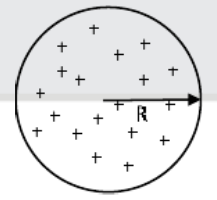Let a total charge 2Q be distributed in a sphere of radius R, with the charge density given by , ρ(r)=kr, where r is the distance from the centre. Two charge A and B, of –Q each, are placed on diametrically opposite points, at equal distance, a from the centre. If A and B do not experience any force, then:
a=2−1/4R
a=R√3
a=8−1/4R
a=3R21/4
The correct Answer is:C
To solve the problem, we need to analyze the situation step by step, considering the distribution of charge and the forces acting on charges A and B.
Step 1: Understand the Charge Distribution
We have a total charge of 2Q distributed in a sphere of radius R with a charge density given by:
ρ(r)=kr
where r is the distance from the center of the sphere.
Step 2: Calculate the Total Charge
To find the value of k, we need to ensure that the total charge within the sphere equals 2Q. The total charge can be calculated by integrating the charge density over the volume of the sphere:
Qtotal=∫R0ρ(r)dV=∫R0kr⋅4πr2dr
This gives:
Qtotal=4πk∫R0r3dr=4πk(r44)R0=πkR4
Setting this equal to 2Q:
πkR4=2Q⟹k=2QπR4
Step 3: Calculate the Electric Field Inside the Sphere
Using Gauss's law, we can find the electric field E at a distance a from the center (where charges A and B are placed). The charge enclosed by a Gaussian surface of radius a is:
Qenc=∫a0ρ(r)dV=∫a0kr⋅4πr2dr=4πk∫a0r3dr=4πk(r44)a0=πka4
Substituting k:
Qenc=π(2QπR4)a4=2Qa4R4
Using Gauss's law:
∮E⋅dA=Qencϵ0⟹E⋅4πa2=2Qa4ϵ0R4
Thus,
E=2Qa24πϵ0R4=Qa22πϵ0R4
Step 4: Calculate the Forces on Charges A and B
The force on charge A due to charge B is given by Coulomb's law:
FAB=14πϵ0(−Q)(−Q)(2a)2=Q24πϵ0(2a)2=Q216πϵ0a2
The force on charge A due to the electric field from the sphere is:
FES=Q⋅E=Q⋅Qa22πϵ0R4=Q2a22πϵ0R4
Step 5: Set the Forces Equal
Since charges A and B do not experience any force, we set FAB=FES:
Q216πϵ0a2=Q2a22πϵ0R4
Cancelling Q2 and rearranging gives:
116a2=a22R4⟹2R4=16a4⟹R4=8a4⟹a=R√(4)8=R23/4
Final Answer
Thus, we find:
a=R23/4
We have a total charge of 2Q distributed in a sphere of radius R with a charge density given by:
ρ(r)=kr
where r is the distance from the center of the sphere.
To find the value of k, we need to ensure that the total charge within the sphere equals 2Q. The total charge can be calculated by integrating the charge density over the volume of the sphere:
Qtotal=∫R0ρ(r)dV=∫R0kr⋅4πr2dr
This gives:
Qtotal=4πk∫R0r3dr=4πk(r44)R0=πkR4
Setting this equal to 2Q:
πkR4=2Q⟹k=2QπR4
Using Gauss's law, we can find the electric field E at a distance a from the center (where charges A and B are placed). The charge enclosed by a Gaussian surface of radius a is:
Qenc=∫a0ρ(r)dV=∫a0kr⋅4πr2dr=4πk∫a0r3dr=4πk(r44)a0=πka4
Substituting k:
Qenc=π(2QπR4)a4=2Qa4R4
∮E⋅dA=Qencϵ0⟹E⋅4πa2=2Qa4ϵ0R4
Thus,
E=2Qa24πϵ0R4=Qa22πϵ0R4
The force on charge A due to charge B is given by Coulomb's law:
FAB=14πϵ0(−Q)(−Q)(2a)2=Q24πϵ0(2a)2=Q216πϵ0a2
The force on charge A due to the electric field from the sphere is:
FES=Q⋅E=Q⋅Qa22πϵ0R4=Q2a22πϵ0R4
Since charges A and B do not experience any force, we set FAB=FES:
Q216πϵ0a2=Q2a22πϵ0R4
Cancelling Q2 and rearranging gives:
116a2=a22R4⟹2R4=16a4⟹R4=8a4⟹a=R√(4)8=R23/4
Thus, we find:
a=R23/4
Similar Questions
A sphere of radius R carries charge density p proportional to the square of the distance from the centre such that p=Cr2, where C is a positive constant. At a distance R/2 from the centre, the magnitude of the electric field is :
View SolutionCharge is distributed within a sphere of radius R with a volume charge density p(r)=Ar2e−2r/a, where A and a are constants. If Q is the total charge of this charge distribution, the radius R is :
View Solution
Knowledge Check
A sphere of radius R has a charge density σ. The electric intensity at a point at a distance r from its centre is
AE=σR2∈0kr2BE=σ∈0kCE=R2DE=∈0kr2σ2Let a total charge 2Q be distributed in a sphere of radius R, with the charge density given by , ρ(r)=kr, where r is the distance from the centre. Two charge A and B, of –Q each, are placed on diametrically opposite points, at equal distance, a from the centre. If A and B do not experience any force, then:
Aa=R/2Ba=RCa=2RDa=3R/4Charge density of a sphere of radius R is ρ=ρ0r where r is distance from centre of sphere.Total charge of sphere will be
 AρπeR2B2ρ0πeR2C3ρ0πeR2D4ρ0πeR2
AρπeR2B2ρ0πeR2C3ρ0πeR2D4ρ0πeR2
A solid sphere of radius R has total charge Q. The charge is distributed in spherically symmetric manner in the sphere. The charge density is zero at the centre and increases linearly with distance from the centre. (a) Find the charge density at distance r from the centre of the sphere. (b) Find the magnitude of electric field at a point ‘P’ inside the sphere at distance r1 from the centre.
View SolutionCharge Q is distributed on two concentric spheres of radius r and R resp. if charge density of both spheres is same then electric potential at centre will be
View SolutionA sphere of radius R carries charge such that its volume charge density is proportional to the square of the distance from the centre. What is the ratio of the magnitude of the electric field at a distance 2 R from the centre to the magnitude of the electric field at a distance of R/2 from the centre?
View SolutionA spherical shell of radius R is given charge 3q on its surface and a point charge q is placed at distance R/2 from its centre C. Also there is a charge 2q placed outside the shell at a distance of 2R as shown. Then

View SolutionLet P(r)=QπR4r be the charge density distribution for a solid sphere of radius R and total charge Q. For a point 'p' inside the sphere at distance r1 from the centre of the sphere, the magnitude of electric field is:
View Solution
